Abstract
When the heart ceases to meet the requirements of the body for oxygen, the sympathetic-adrenal system is activated. This occurs in people with a healthy heart when the demands for oxygen are excessive—for example, in heavy muscular work—and in subjects with a failing heart when the demands are normal or small. Eventually, when the heart is unable to meet even the ordinary requirements of everyday life, the sympathetic activity becomes more or less continuous. It may lessen during rest at night, but with a further failing of the heart its output may become inadequate even in complete rest.
The sympathetically-medicated renal vasoconstriction, with reduction of the glomerular sodium load, redistribution of the blood flow in the renal cortex to the juxtamedullary glomeruli, and the mobilization of the renin-angiotensin-aldosterone system, is responsible for the salt and water retention which will ultimately become clinically manifest as oedema—especially when it is no longer counteracted by the tidal output of water and sodium at night. A by-product of this continuing dehydration reaction is a cumulative potassium loss which may lead to disastrous consequences if untreated.
Full text
PDF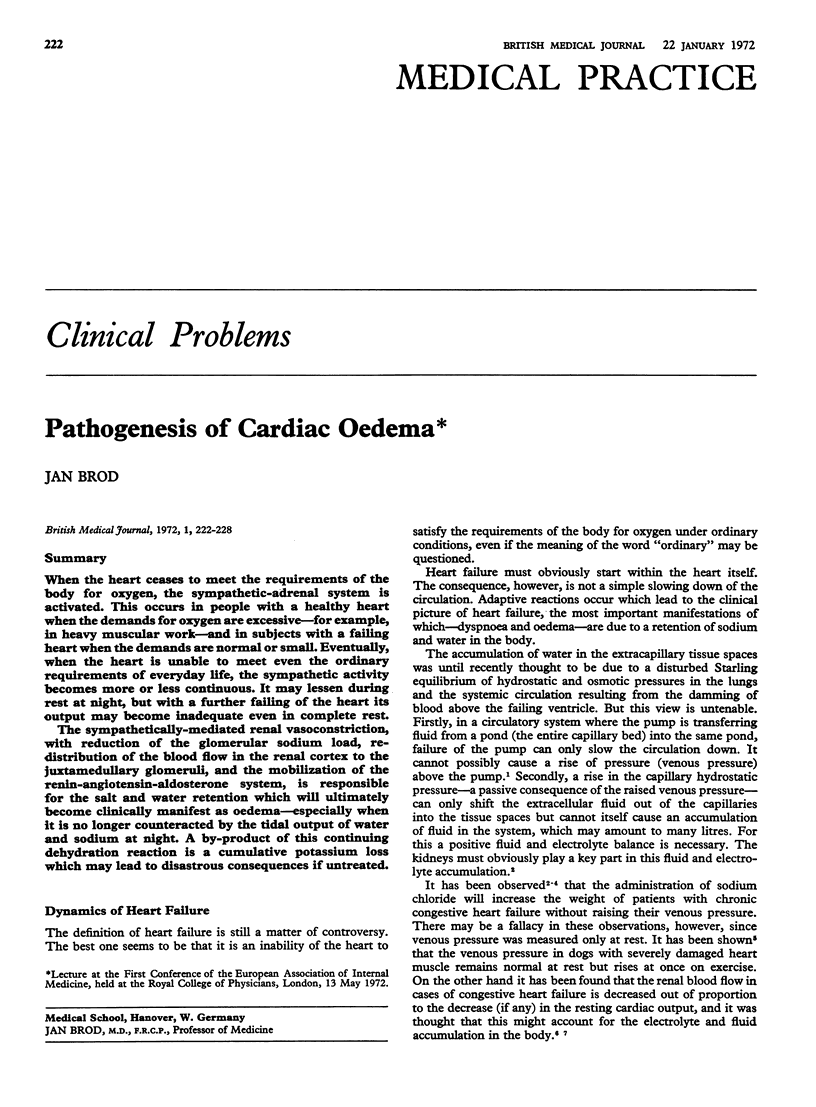
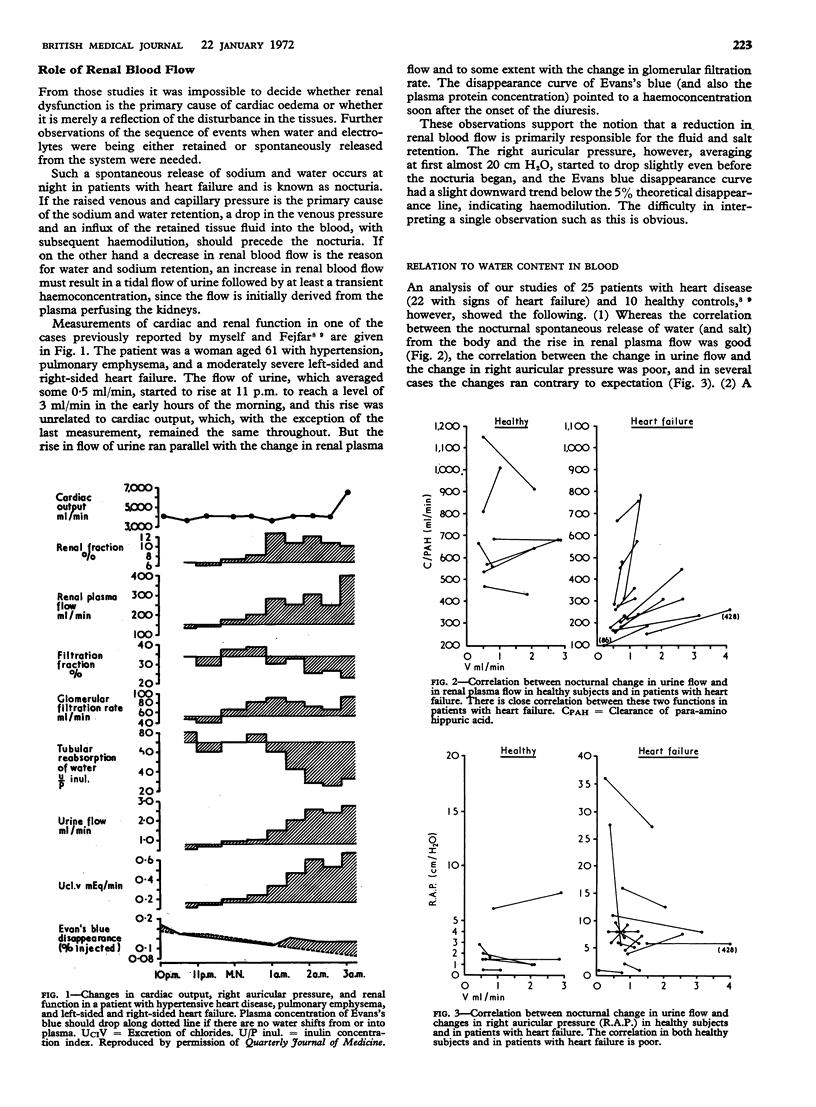
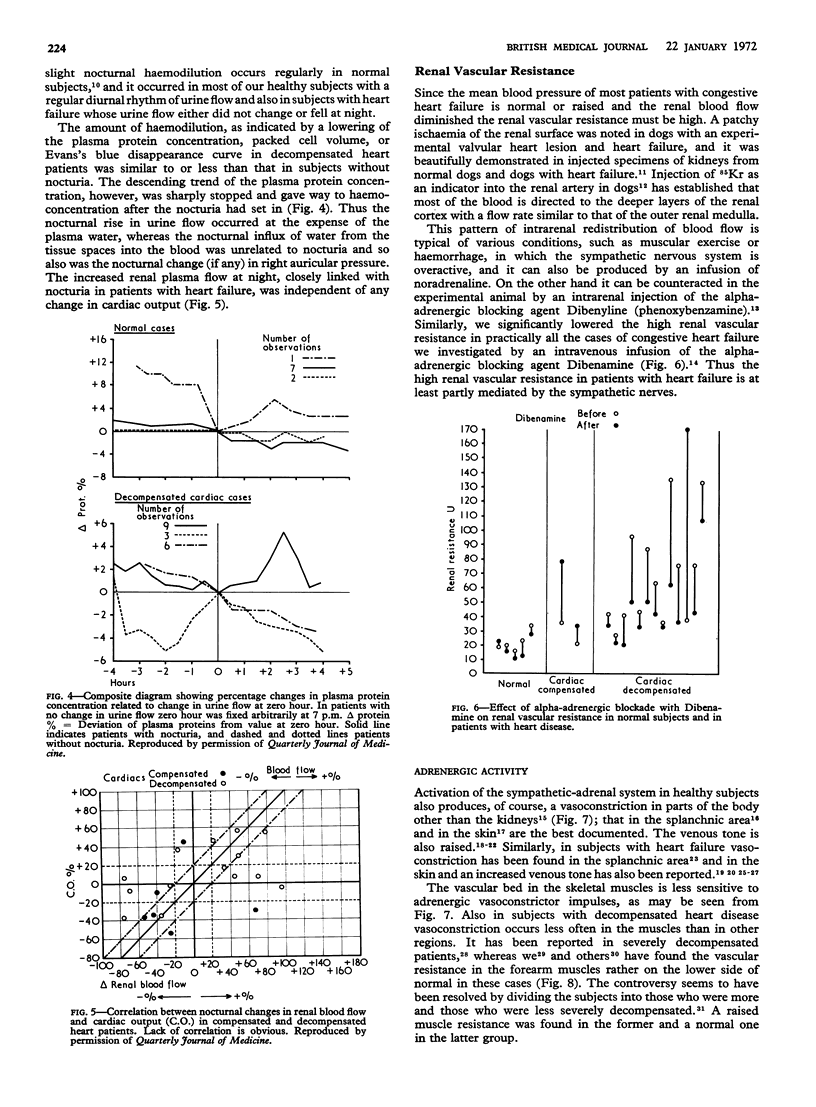
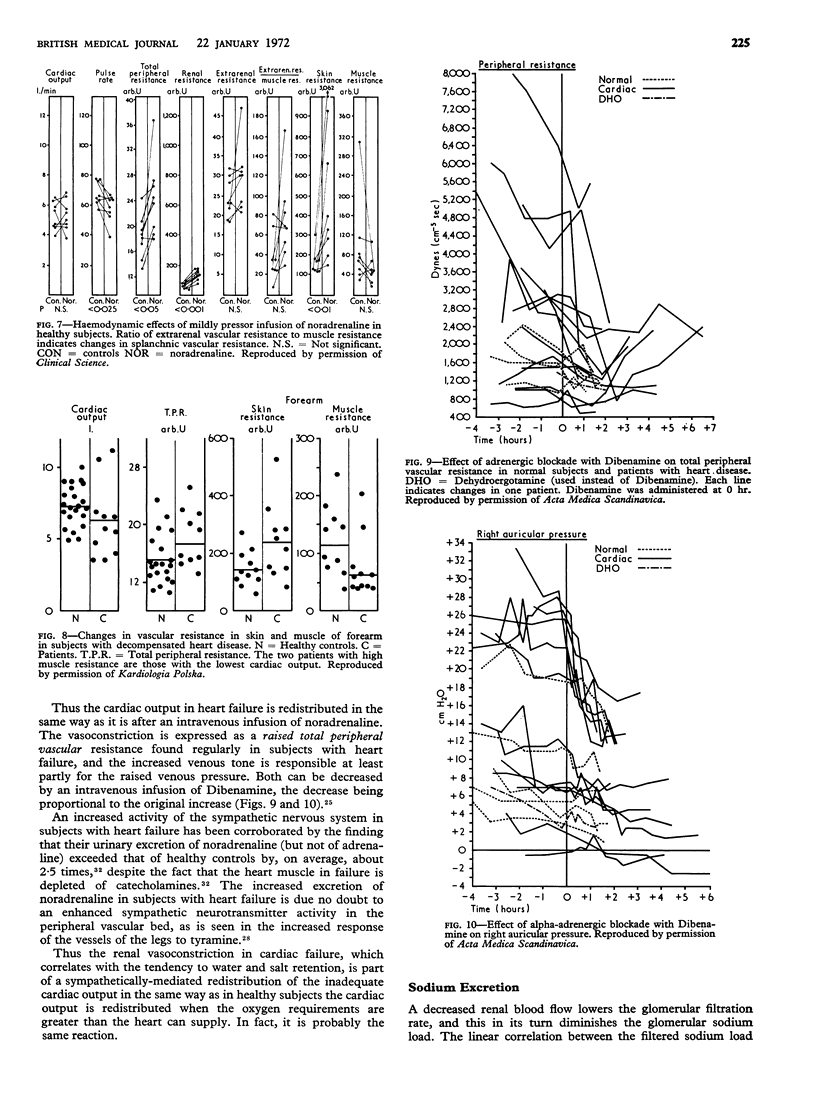

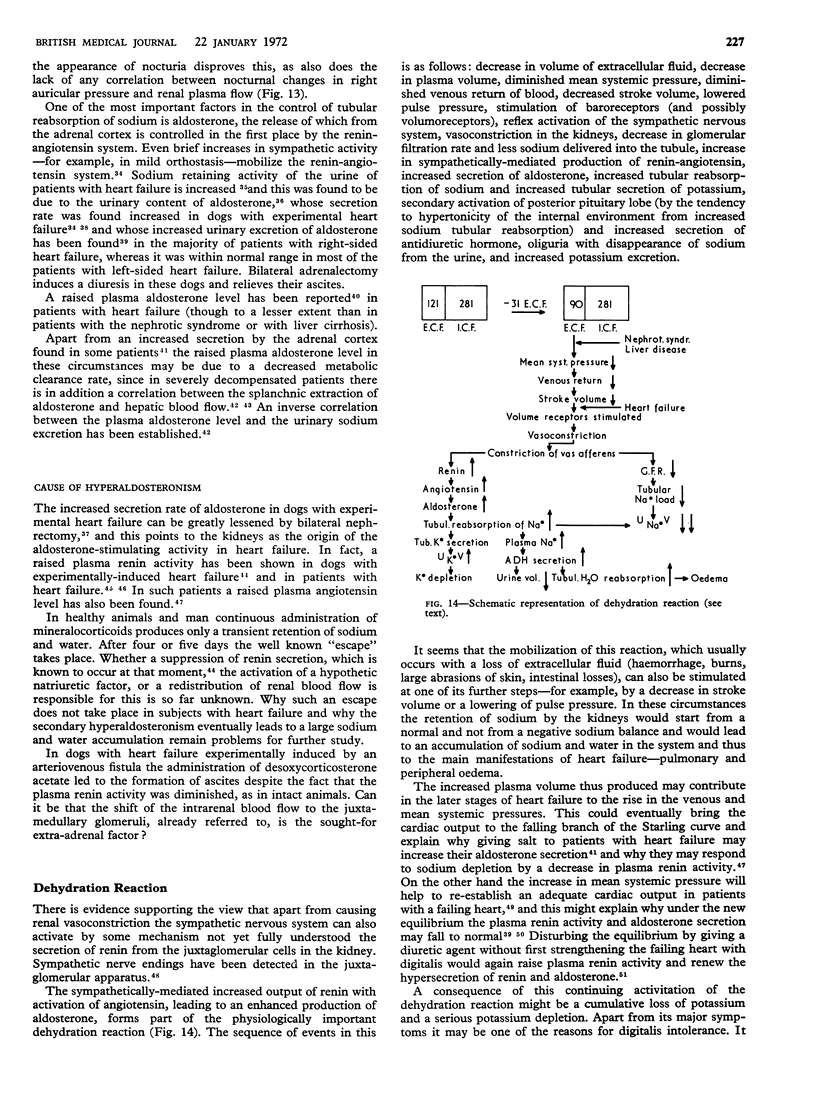
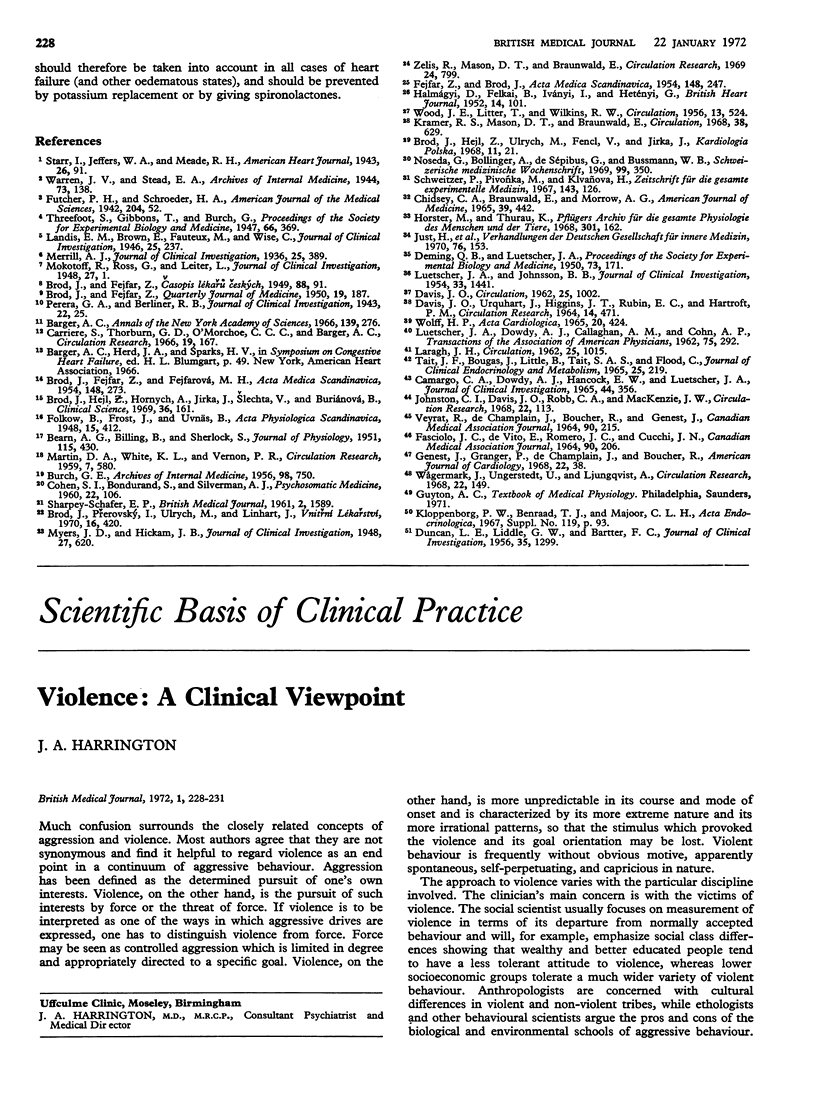
Selected References
These references are in PubMed. This may not be the complete list of references from this article.
- BARTTER F. C., DUNCAN L. E., Jr, LIDDLE G. W. The effect of changes in body sodium on extracellular fluid volume and aldosterone and sodium excretion by normal and edematous men. J Clin Invest. 1956 Nov;35(11):1299–1305. doi: 10.1172/JCI103385. [DOI] [PMC free article] [PubMed] [Google Scholar]
- BEARN A. G., BILLING B., SHERLOCK S. The effect of adrenaline and noradrenaline on hepatic blood flow and splanchnic carbohydrate metabolism in man. J Physiol. 1951 Dec 28;115(4):430–441. doi: 10.1113/jphysiol.1951.sp004679. [DOI] [PMC free article] [PubMed] [Google Scholar]
- BROD J., FEJFAR Z., FEJFAROVA M. H. The role of neuro-humoral factors in the genesis of renal haemodynamic changes in heart failure. Acta Med Scand. 1954;148(4):273–290. doi: 10.1111/j.0954-6820.1954.tb01720.x. [DOI] [PubMed] [Google Scholar]
- Brod J., Hejl Z., Hornych A., Jirka J., Slechta V., Buriánová B. Comparison of haemodynamic effects of equipressor doses of intravenous angiotensin and noradrenaline in man. Clin Sci. 1969 Apr;36(2):161–172. [PubMed] [Google Scholar]
- Brod J., Prerovský I., Ulrych M., Linhart J. Vliv emochího stressu (mentální aritmetiky) na zilní obeh. Vnitr Lek. 1970 May;16(5):420–427. [PubMed] [Google Scholar]
- CAMARGO C. A., DOWDY A. J., HANCOCK E. W., LUETSCHER J. A. DECREASED PLASMA CLEARANCE AND HEPATIC EXTRACTION OF ALDOSTERONE IN PATIENTS WITH HEART FAILURE. J Clin Invest. 1965 Mar;44:356–365. doi: 10.1172/JCI105149. [DOI] [PMC free article] [PubMed] [Google Scholar]
- CHIDSEY C. A., BRAUNWALD E., MORROW A. G. CATECHOLAMINE EXCRETION AND CARDIAC STORES OF NOREPINEPHRINE IN CONGESTIVE HEART FAILURE. Am J Med. 1965 Sep;39:442–451. doi: 10.1016/0002-9343(65)90211-1. [DOI] [PubMed] [Google Scholar]
- COHEN S. I., BONDURANT S., SILVERMAN A. J. Psychophysiological influences on peripheral venous tone. Psychosom Med. 1960 Mar-Apr;22:106–117. doi: 10.1097/00006842-196003000-00003. [DOI] [PubMed] [Google Scholar]
- DAVIS J. O. Adrenocortical and renal hormonal function in experimental cardiac failure. Circulation. 1962 Jun;25:1002–1014. doi: 10.1161/01.cir.25.6.1002. [DOI] [PubMed] [Google Scholar]
- DAVIS J. O., URQUHART J., HIGGINS J. T., Jr, RUBIN E. C., HARTROFT P. M. HYPERSECRETION OF ALDOSTERONE IN DOGS WITH A CHRONIC AORTIC-CAVAL FISTULA AND HIGH OUTPUT HEART FAILURE. Circ Res. 1964 Jun;14:471–485. doi: 10.1161/01.res.14.6.471. [DOI] [PubMed] [Google Scholar]
- FASCIOLO J. C., DEVITO E., ROMERO J. C., CUCCHI J. N. THE RENIN CONTENT OF THE BLOOD OF HUMANS AND DOGS UNDER SEVERAL CONDITIONS. Can Med Assoc J. 1964 Jan 25;90:206–209. [PMC free article] [PubMed] [Google Scholar]
- FEJFAR Z., BROD J. The mechanism of general haemodynamic changes in heart failure. Acta Med Scand. 1954;148(4):247–272. doi: 10.1111/j.0954-6820.1954.tb01719.x. [DOI] [PubMed] [Google Scholar]
- HALMAGYI D., FELKAI B., IVANYI J., HETENYI G., Jr The role of the nervous system in the maintenance of venous hypertension in heart failure. Br Heart J. 1952 Jan;14(1):101–111. doi: 10.1136/hrt.14.1.101. [DOI] [PMC free article] [PubMed] [Google Scholar]
- Horster M., Thurau K. Micropuncture studies on the filtration rate of single superficial and juxtamedullary glomeruli in the rat kidney. Pflugers Arch Gesamte Physiol Menschen Tiere. 1968;301(2):162–181. doi: 10.1007/BF00362733. [DOI] [PubMed] [Google Scholar]
- Johnston C. I., Davis J. O., Robb C. A., Mackenzie J. W. Plasma renin in chronic experimental heart failure and during renal sodium "escape" from mineralocorticoids. Circ Res. 1968 Feb;22(2):113–125. doi: 10.1161/01.res.22.2.113. [DOI] [PubMed] [Google Scholar]
- Kramer R. S., Mason D. T., Braunwald E. Augmented sympathetic neurotransmitter activity in the peripheral vascular bed of patients with congestive heart failure and cardiac norepinephrine depletion. Circulation. 1968 Oct;38(4):629–634. doi: 10.1161/01.cir.38.4.629. [DOI] [PubMed] [Google Scholar]
- LARAGH J. H. Hormones and the pathogenesis of congestive heart failure: vasopressin, aldosterone, and angiotensin II. Further evidence for renal-adrenal interaction from studies in hypertension and in cirrhosis. Circulation. 1962 Jun;25:1015–1023. doi: 10.1161/01.cir.25.6.1015. [DOI] [PubMed] [Google Scholar]
- LITTER J., WILKINS R. W., WOOD J. E. Peripheral venoconstriction in human congestive heart failure. Circulation. 1956 Apr;13(4):524–527. doi: 10.1161/01.cir.13.4.524. [DOI] [PubMed] [Google Scholar]
- LUETSCHER J. A., Jr, JOHNSON B. B. Observations on the sodium-retaining corticoid (aldosterone) in the urine of children and adults in relation to sodium balance and edema. J Clin Invest. 1954 Nov;33(11):1441–1446. doi: 10.1172/JCI103022. [DOI] [PMC free article] [PubMed] [Google Scholar]
- Landis E. M., Brown E., Fauteux M., Wise C. CENTRAL VENOUS PRESSURE IN RELATION TO CARDIAC "COMPETENCE," BLOOD VOLUME AND EXERCISE. J Clin Invest. 1946 Mar;25(2):237–255. doi: 10.1172/JCI101702. [DOI] [PMC free article] [PubMed] [Google Scholar]
- MARTIN D. A., WHITE K. L., VERNON C. R. Influence of emotional and physical stimuli on pressure in the isolated vein segment. Circ Res. 1959 Jul;7(4):580–587. doi: 10.1161/01.res.7.4.580. [DOI] [PubMed] [Google Scholar]
- Mokotoff R., Ross G., Leiter L. RENAL PLASMA FLOW AND SODIUM REABSORPTION AND EXCRETION IN CONGESTIVE HEART FAILURE. J Clin Invest. 1948 Jan;27(1):1–9. doi: 10.1172/JCI101911. [DOI] [PMC free article] [PubMed] [Google Scholar]
- Myers J. D., Hickam J. B. AN ESTIMATION OF THE HEPATIC BLOOD FLOW AND SPLANCHNIC OXYGEN CONSUMPTION IN HEART FAILURE. J Clin Invest. 1948 Sep;27(5):620–627. doi: 10.1172/JCI102008. [DOI] [PMC free article] [PubMed] [Google Scholar]
- Noseda G., Bollinger A., de Sépibus G., Bussmann W. D. Unterarmdurchblutung und Kreislaufzeiten bei Herzinsuffizienz. Schweiz Med Wochenschr. 1969 Mar 15;99(11):350–355. [PubMed] [Google Scholar]
- Perera G. A., Berliner R. W. THE RELATION OF POSTURAL HEMODILUTION TO PAROXYSMAL DYSPNEA. J Clin Invest. 1943 Jan;22(1):25–28. doi: 10.1172/JCI101364. [DOI] [PMC free article] [PubMed] [Google Scholar]
- SHARPEY-SCHAFER E. P. Venous tone. Br Med J. 1961 Dec 16;2(5267):1589–1595. doi: 10.1136/bmj.2.5267.1589. [DOI] [PMC free article] [PubMed] [Google Scholar]
- Schweitzer P., Pivonka M., Klvanová H. The blood flow in the forearm in patients with cardiac failure. I. The relationship between the cardiac output and the blood flow in the forearm. Z Gesamte Exp Med. 1967;143(2):126–135. doi: 10.1007/BF02042880. [DOI] [PubMed] [Google Scholar]
- TAIT J. F., LITTLE B., TAIT S. A., FLOOD C., BOUGAS J. SPLANCHNIC EXTRACTION AND CLEARANCE OF ALDOSTERONE IN SUBJECTS WITH MINIMAL AND MARKED CARDIAC DYSFUNCTION. J Clin Endocrinol Metab. 1965 Feb;25:219–228. doi: 10.1210/jcem-25-2-219. [DOI] [PubMed] [Google Scholar]
- VEYRAT R., DE CHAMPLAIN J., BOUCHER R., GENEST J. MEASUREMENT OF HUMAN ARTERIAL RENIN ACTIVITY IN SOME PHYSIOLOGICAL AND PATHOLOGICAL STATES. Can Med Assoc J. 1964 Jan 25;90:215–220. [PMC free article] [PubMed] [Google Scholar]
- Wolff H. P. Aldosterone in congestive heart failure. Acta Cardiol. 1965;20(5):424–434. [PubMed] [Google Scholar]
- Wågermark J., Ungerstedt U., Ljungqvist A. Sympathetic innervation of the juxtaglomerular cells of the kidney. Circ Res. 1968 Feb;22(2):149–153. doi: 10.1161/01.res.22.2.149. [DOI] [PubMed] [Google Scholar]
- Zelis R., Mason D. T., Braunwald E. Partition of blood flow to the cutaneous and muscular beds of the forearm at rest and during leg exercise in normal subjects and in patients with heart failure. Circ Res. 1969 Jun;24(6):799–806. doi: 10.1161/01.res.24.6.799. [DOI] [PubMed] [Google Scholar]


